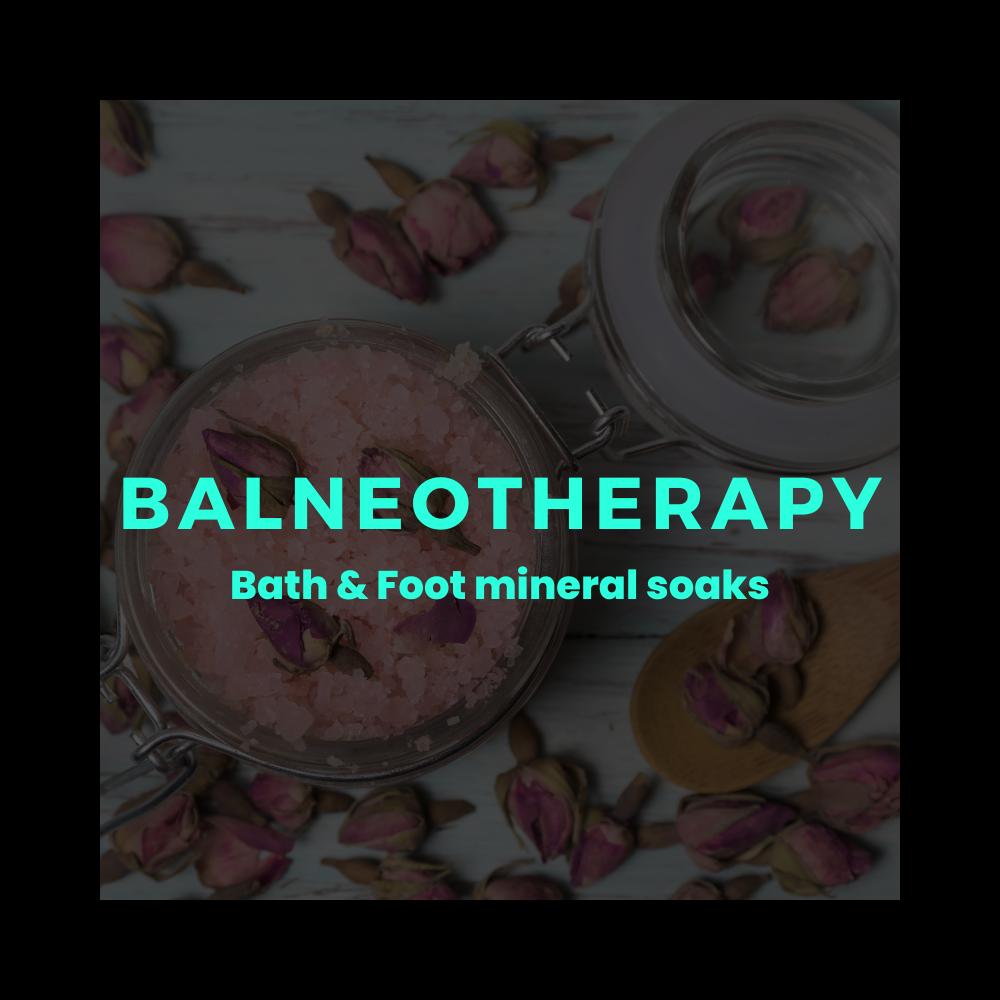SOAKING FOR HEALTH & WELLNESS
The aim of these treatments may be to enhance the immune system, stimulate circulatory processes
including lymph and blood circulation, accelerate cell activity, dilate tissue and vessels, and activate the self-healing potential naturally.
For centuries the benefits of therapeutic bathing have been recognized for the ability
to relieve pain and improve the general well being of the body and spirit. In fact, balneotherapy is one of the oldest of medical procedures, well known and widely regarded throughout Europe and Asia.
Balneotherapy, the art of water therapy, is a perfect way for herbs, minerals and essential oils to enter the body for healing. Water is nature’s greatest and most effective solvent. It acts as a liquid suspension, carrying a variety of minerals and chemicals (essential oils, herbs etc). When we immerse our bodies or feet in a warm bath, our skin rapidly begins to absorb chemicals that are suspended in the water. These chemicals can make their way into our bloodstream in as little as 2 to 15 minutes.
HEALING WATERS
Over the several hundred years during which science of medical balneotherapy has
developed, physicians have been able to identify the health conditions that can best be
treated by healing waters. The following List of indications for balneotherapy is based on the research. Drop down menu had external research links for your review
BATH & FOOT SOAKS
-

Balneotherapy (BATH)
SOAKING FOR HEALTH AND WELLNESS The aim of these treatments may be...
Balneotherapy Health Benefits based on Science
Chronic rheumatic diseases
Therapeutic Benefits of Balneotherapy on Quality of Life of Patients with Rheumatoid Arthritis: A Systematic Review
Int J Environ Res Public Health.2021 Dec; 18(24): 13216.Published online 2021 Dec 15 PMCID:PMC8701266
Background: Rheumatoid arthritis (RA) is the most common inflammatory rheumatic disease. RA symptoms make the disease disabling and strongly impact the quality of life of patients. Among the available forms of treatment, balneotherapy seems to be one of the most common forms of nonpharmacological treatment for rheumatic disease. The aim was to explore the effectiveness of balneotherapy for improving the quality of life of patients with RA. Methods: Pubmed, Scopus, Web of Science and The Cochrane library were searched for randomized or clinical controlled trials. A total 535 records were retrieved, and seven met the inclusion criteria. All the included studies showed statistically significant improvements in the quality of life of patients who received balneotherapy treatment. Sessions should be approximately 20 min long and use natural mineral waters enriched with elements, or mud, at a water temperature between 35–38 °C. Conclusions: Balneotherapy benefits the quality of life of people with RA. The obtained results show positive effects for both mineral bathing and immersion in sand or mud on the quality of life of people who suffer from RA.
Chronic Skin Diseases
Who uses balneotherapy?
Balneotherapy is used for the treatment of chronic inflammatory conditions particularly skin conditions such as psoriasis and atopic dermatitis, and rheumatological conditions.
How is balneotherapy done?
Traditional balneotherapy involves bathing in waters of naturally-occurring mineral springs; well known sites include the Dead Sea in Israel and Jordan, the Kangal Hot Springs in Turkey, and the Blue Lagoon in Iceland. Balneotherapy is also offered by spas or treatment centres using naturally-sourced mineral water or synthetic salt solutions. A simple form of balneotherapy can be done at home by dissolving minerals or salts in baths, such as sea salts and Epsom salts (magnesium sulfate).
READ ON (external link)
“Board-certified dermatologists are recommending sea salt baths for patients with psoriasis, eczema, and other dry skin conditions"
“Salt baths can help remove scales and decrease the bothersome itching caused by psoriasis" Sea salts may help people dealing with acne and atopic dermatitis
Colloidal oatmeal is a natural solution to many health concerns. For example, a 2012 study showed that colloidal oatmeal helped to reduce the use of corticosteroid and calcineurin inhibitors in patients with atopic dermatitis.
People use oatmeal to treat a variety of skin conditions, including:
- atopic dermatitis
- chickenpox
- contact dermatitis
- diaper rash
- dry, itchy skin
- eczema
- psoriasis
- reactions to insect bites and plants.
Chronic gastrointestinal & Digestive diseases
Digestive system diseases cover diseases of the gastrointestinal tract, of the gall bladder, the liver and the pancreas.
In the study by Dandinoğlu et al. (2016), 2 weeks of spa treatment was found to improve gastrointestinal motility in patients with chronic constipation to the point that their intake of laxatives was reduced and quality of life was positively impacted
Osteoarthritis
Spa therapy and knee osteoarthritis: A systematic review
Chronic low back pain
Effectiveness of balneotherapy and spa therapy for the treatment of chronic low back pain: a review on latest evidence
All reviewed trials reported that balneotherapy was superior in long term to tap water therapy in relieving pain and improving function and that spa therapy combining balneotherapy with mud pack therapy and/or exercise therapy, physiotherapy, and/or education was effective in the management of low back pain
Metabolic diseases, especially diabetes,obesity, and gout
Immune System and Stress Response
Balneotherapy, Immune System, and Stress Response: A Hormetic Strategy?
Circulatory diseases, especially moderateto mild hypertension
Peripheral circulatory diseases(affecting the hands and feet)
Autonomic nervous system dysfunction
Psychosomatic and stress-related diseases
Vibration disorders (middle ear disorders affectingbalance)
Chronic gynecological diseases
OTHER COLLECTIONS
-

The FARMACY Collection
Artisan made herbal remedies collection. Including loose leaf medicinal herbs, herbal glycerites...
-

PREFERRED SUPPLIERS
Preferred suppliers I used and love: DOWN TO EARTH - CBD PRODUCTS ...




